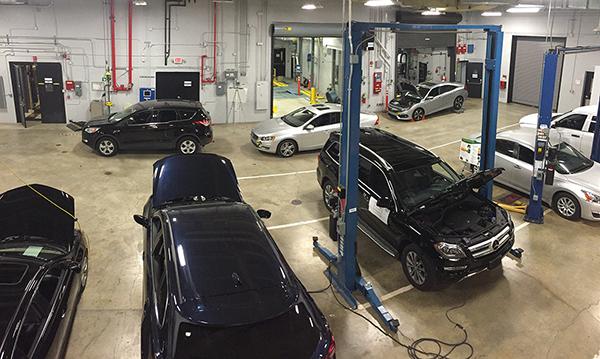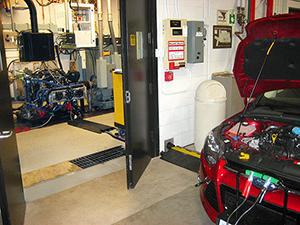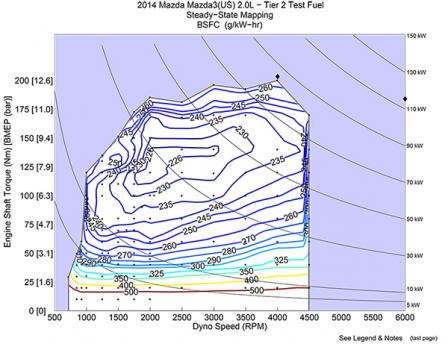Benchmarking Advanced Low Emission Light-Duty Vehicle Technology
- Overview of Advanced Low Emission Vehicle Technology Benchmarking
- Test Data Packages from Benchmarking
- Technical Publications and Presentations Concerning Benchmarking
Overview of Advanced Low Emission Vehicle Technology Benchmarking
 NVFEL Laboratory Benchmarking Test SitesThe National Center for Advanced Technology (NCAT), part of the National Vehicle and Fuel Emissions Laboratory (NVFEL), assesses the effectiveness of advanced low emission and low fuel consumption technologies for a broad range of key light-duty vehicles, engines and transmissions. The NCAT team benchmarks advanced technologies using laboratory test methods to characterize engine controls and measure emissions and fuel consumption. Technologies benchmarked thus far include boosted and high compression ratio naturally-aspirated engines (containing advanced components such as variable valve lift, cylinder deactivation and integrated exhaust manifolds), high-ratio automatic transmissions, continuous variable transmissions, and hybrid components.
NVFEL Laboratory Benchmarking Test SitesThe National Center for Advanced Technology (NCAT), part of the National Vehicle and Fuel Emissions Laboratory (NVFEL), assesses the effectiveness of advanced low emission and low fuel consumption technologies for a broad range of key light-duty vehicles, engines and transmissions. The NCAT team benchmarks advanced technologies using laboratory test methods to characterize engine controls and measure emissions and fuel consumption. Technologies benchmarked thus far include boosted and high compression ratio naturally-aspirated engines (containing advanced components such as variable valve lift, cylinder deactivation and integrated exhaust manifolds), high-ratio automatic transmissions, continuous variable transmissions, and hybrid components.
NCAT leverages best laboratory testing practices to evaluate advanced vehicle, engine and transmission technology. The test data are used for a variety of purposes including documenting engine performance in complete engine maps, performing technical analyses regarding technology effectiveness, and providing information for complete vehicle simulations with the Advanced Light-Duty Powertrain and Hybrid Analysis (ALPHA) tool. Both laboratory test data and ALPHA simulation results have been used to support technical engineering analyses of CO2 emissions from advanced automotive technologies which could be used to meet light-duty vehicle standards, as well as in numerous technical papers. For more information on the ALPHA Tool, see:
One of the goals in establishing an extensive engine and vehicle benchmarking program is to determine appropriate modeling guidelines to ensure robust, consistent and meaningful outputs. For an overview presentation of the benchmarking and simulation activities presented at the 2016 SAE Government Industry Meeting, see:
Test Data Packages from Benchmarking
 Tethered Vehicle-Engine Benchmarking
Tethered Vehicle-Engine Benchmarking Partial Engine Fuel Consumption Map
Partial Engine Fuel Consumption MapNCAT benchmark testing evaluates and characterizes vehicle, engine and transmission behaviors over specified test cycles and methods. Data from these tests are collected into test data packages which describe the test procedures and provide the results from benchmarking various advanced technology components. The test data packages include at a minimum partial engine maps from steady-state testing like the one shown at the right. These maps show the engine’s performance results over the range it was actually tested and confirmed in the laboratory. When available, engine test data packages also include details about idle, wide-open throttle, motoring, high load enrichment and cylinder deactivation operation.
Following EPA’s commitment to transparency, NCAT publishes the test data packets from benchmarking for use in other modeling and analysis activities. The test data packages below contain test report documentation which describes in detail how the testing was conducted, the data that were measured and a spreadsheet file containing the corresponding test data for use in technical analyses. Please use the citation included in each test report when referencing any of these documents.
Engine Test Data
- 2018 Toyota 2.5L A25A-FKS Engine Tier 2 Fuel - Test Data Package - Dated 07-28-20 (ZIP)(32 MB, July 2020)
- 2018 Toyota 2.5L A25A-FKS Engine Tier 3 Fuel – Test Data Package - Dated 07-28-20 (ZIP)(31 MB, July 2020)
- 2016 Mazda 2.5L Turbo Skyactiv-G Engine Tier 2 Fuel – Test Data Package – Dated 03-13-19 (ZIP)(8 MB, March 2019)
- 2016 Mazda 2.5L Turbo Skyactiv-G Engine Tier 3 Fuel – Test Data Package – Dated 03-13-19 (ZIP)(9 MB, March 2019)
- 2016 Honda 1.5L L15B7 Engine Tier 2 Fuel - Test Data Package - Dated 02-04-19 (ZIP)(25 MB, February 2019)
- 2016 Honda 1.5L L15B7 Engine Tier 3 Fuel - Test Data Package - Dated 02-04-19 (ZIP)(25 MB, February 2019)
- 2013 Ford 1.6L EcoBoost Engine Tier 2 Fuel - Test Data Package - Dated 10-25-18 (ZIP)(5 MB, December 2018)
- 2013 Ford 1.6L EcoBoost Engine LEV III Fuel - Test Data Package - Dated 10-25-18 (ZIP)(5 MB, December 2018)
- 2014 Chevrolet 4.3L EcoTec LV3 Engine Tier 2 Fuel - Test Data Package - Dated 10-25-18 (ZIP)(5 MB, December 2018)
- 2014 Chevrolet 4.3L EcoTec LV3 Engine LEV III Fuel - Test Data Package - Dated 10-25-18 (ZIP)(6 MB, December 2018)
- 2015 BMW 3.0L N57 Engine Diesel Fuel - Test Data Package - Dated 06-11-18 (ZIP)(16 MB, December 2018)
- 2013 Chevrolet 2.5L Ecotec LCV Engine Reg E10 Fuel - Test Data Package – Dated 03-05-18 (ZIP)(10 MB, March 2018)
- 2014 Mazda 2.0L Skyactiv Engine Tier 2 Fuel - Test Data Package - Dated 03-29-18 (ZIP)(6 MB, March 2018)
- 2014 Mazda 2.0L Skyactiv Engine LEV III Fuel - Test Data Package - Dated 03-29-18 (ZIP)(6 MB, March 2018)
- 2015 Ford 2.7L EcoBoost V6 Engine Tier 2 Fuel Cell 9 – Test Data Package – Dated 11-27‐19 (ZIP)(3 MB, November 2019)
- 2015 Ford 2.7L EcoBoost V6 Engine Tier 2 Fuel HD1 – Test Data Package – Dated 11-27‐19 (ZIP)(4 MB, November 2019)
- 2015 Ford 2.7L EcoBoost V6 Engine LEV III Fuel Cell 9 – Test Data Package – Dated 11-27‐19 (ZIP)(3 MB, November 2019)
- 2015 Ford 2.7L EcoBoost V6 Engine Tier 3 Fuel HD1 – Test Data Package – Dated 11-27‐19 (ZIP)(4 MB, November 2019)
Transmission Test Data
- 2018 Toyota UB80E Transmission - Test Data Package - Dated 07-28-20 (ZIP)(23 MB, July 2020)
- 2013 Nissan Jatco CVT8 Transmission - Test Data Package - Dated 07-15-19 (ZIP)(11 MB, July 2019)
- 2013 GM 6T40 Transmission – Test Data Package – Dated 05‐09‐19 (ZIP)(11 MB, May 2019)
- 2014 FCA HFE 845RE Transmission – Test Data Package – Dated 04‐09‐19 (ZIP)(18 MB, May 2019)
- 2014 GM 6L80 Transmission - Test Data Package - Dated 12-13-18 (ZIP)(8 MB, December 2018)
Vehicle Test Data
- 2018 Mazda6 Sport Vehicle Tier 2 Fuel ‐ Test Data Package ‐ Dated 11‐02‐20 (ZIP)(365 MB, November 2020)
- 2018 Toyota Camry LE Vehicle Tier 2 Fuel - Test Data Package - Dated 07-30-20 (ZIP)(222 MB, July 2020)
- 2014 Dodge Charger 3.6L 845RE Vehicles Tier 2 Fuel - Test Data Package - Dated 04-15-19 (ZIP)(46 MB, April 2019)
- 2014 Dodge Charger 3.6L W5A580 Vehicles Tier 2 Fuel - Test Data Package - Dated 04-15-19 (ZIP)(40 MB, April 2019)
- 2013 Chevrolet Malibu 1LS Vehicle Tier 2 & 3 Fuels - Test Data Package - Dated 09-25-18 (ZIP)(41 MB, December 2018)
- 2013 Mercedes E350 BlueTEC Vehicle Diesel Fuel - Test Data Package - Dated 10-25-18 (ZIP)(78 MB, December 2018)
Technical Publications and Presentations Concerning Benchmarking
The technical publications and presentations listed below describe benchmarking studies conducted on vehicles and engines selected for their specific vehicle technology content. The test articles, procedures, and results from benchmarking activities are described and support the goal of publishing research in peer-reviewed papers and journals to increase transparency.
- Daniel Barba, "Assessing The Efficiency Potential of Future Gasoline Engines", SAE 2018 High Efficiency IC Engine Symposium.
- Moskalik, A., “Using Transmission Data to Isolate Individual Losses in Coastdown Road Load Coefficients,” SAE Technical Paper 2020-01-1064, 2020, doi:10.4271/2020-01-1064.
- Moskalik, A., Stuhldreher, M., and Kargul, J., “Benchmarking a 2018 Toyota Cam249783y UB80E Eight-Speed Automatic Transmission,” SAE Technical Paper 2020-01-1286, 2020, doi:10.4271/2020-01-1286.
- Kargul, J., Stuhldreher, M., Barba, D., Schenk, C. et al., “Benchmarking a 2018 Toyota Camry 2.5-Liter Atkinson Cycle Engine with Cooled-EGR,” SAE Int. J. Advances & Curr. Prac. in Mobility 1(2):601-638, 2019, doi:10.4271/2019-01-0249.
- Barba, D., “Benchmarking a 2018 Toyota Camry 2.5-Liter Atkinson Cycle Engine with Cooled-EGR” presented at SAE WCX, Detroit, MI, April 9-11, 2019.
- Bohac, S., “Benchmarking and Characterization of a Full Continuous Cylinder Deactivation System” presented at SAE WCX, Detroit, MI, April 10-12, 2018.
- Stuhldreher, M., Kargul, J., Barba, D., McDonald, J. et al., “Benchmarking a 2016 Honda Civic 1.5-liter L15B7 Turbocharged Engine and Evaluating the Future Efficiency Potential of Turbocharged Engines,” SAE Int. J. Engines 11(6):1273-1305, 2018, doi:10.4271/2018-01-0319.
- “Potential Fuel Economy Improvements from the Implementation of cEGR and CDA on an Atkinson Cycle Engine”, SAE Technical Paper 2017-01-1016, 2017, doi:10.4271/2017-01-1016, Schenk, C., Dekraker, P.
- “Modeling and Validation of 12V Lead-acid Battery for Stop-Start Technology”, SAE Technical Paper 2017-01-1211, 2017, doi:10.4271/2017-01-1211, Lee, S., Cherry, J., Safoutin, M., McDonald, J.
- "Fuel Efficiency Mapping of a 2014 6-Cylinder GM EcoTec 4.3L Engine with Cylinder Deactivation," SAE Technical Paper 2016-01-0662, 2016, doi:10.4271/2016-01-0662, Stuhldreher, M.
- "Benchmarking and Hardware-in-the-Loop Operation of a 2014 MAZDA SkyActiv 2.0L 13:1 Compression Ratio Engine," SAE Technical Paper 2016-01-1007, 2016, doi:10.4271/2016-01-1007, Ellies, B., Schenk, C., and Dekraker, P.
- "Investigating the Effect of Advanced Automatic Transmissions on Fuel Consumption Using Vehicle Testing and Modeling," SAE Int. J. Engines 9(3):2016, doi:10.4271/2016-01-1142, Moskalik, A., Hula, A., Barba, D., and Kargul, J.
- "Downsized Boosted Engine Benchmarking Method and Results," SAE Technical Paper 2015-01-1266, 2015, doi:10.4271/2015-01-1266, Stuhldreher, M., Schenk, C., Brakora, J., Hawkins, D., Moskalik, A., and Dekraker, P.
- "Vehicle Component Benchmarking Using a Chassis Dynamometer," SAE Int. J. Mater. Manf. 8(3):2015, doi:10.4271/2015-01-0589, Moskalik, A., Dekraker, P., Kargul, J., and Barba, D.
